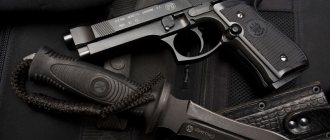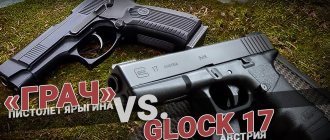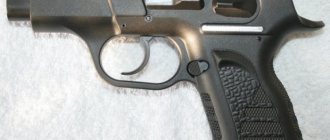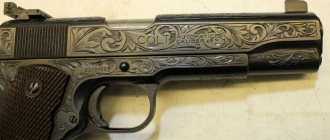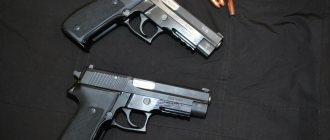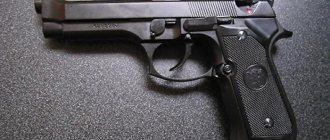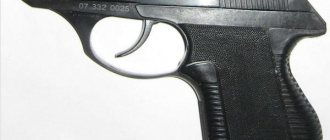The main purpose of civilian weapons is to ensure the safety of life and health from criminal attacks by criminals. But as often happens, it is quite difficult to exercise the right to self-defense with a gas canister or a stun gun. It’s a different matter when you have a weapon, but what kind of weapon is better to have - combat or traumatic and what is the right thing to do so that protecting life in a conflict situation does not result in an accusation of excess authority or unlawful use of weapons.
What is a traumatic pistol
In the general classification of firearms, traumatic weapons are a special type that is subject to strict safety requirements. In Russian legislation, this type of weapon is combined under the concept of firearms with limited destruction. It includes the weapon itself and special ammunition.
Pistols and revolvers with traumatic action may be similar to real combat pistols and revolvers, or they may be made in the form of designs and shapes that do not fit into the usual idea of pistols and revolvers.
A special feature of this type is the design changes in the design of the combat model, in which it loses its combat properties and which, after such changes, cannot be used for firing ammunition with a metal bullet.
Simply put, it is impossible to fire a live cartridge from such a pistol, but it is quite possible to fire a traumatic one. The alteration concerns, first of all, the barrel bore, the return spring, and the mechanism that allows you to fire bursts.
A traumatic pistol uses cartridges that do not match the combat ones in size, and the barrel itself has deformations that, when fired by a rubber bullet, deform it too, thereby reducing the bullet’s flight range to 15-20 meters, while the effective firing range of combat pistol range is 25-50 meters.
pros
Advantages of MP-71:
- easy to use;
- compact;
- relatively light;
- reliable;
- safe protection system;
- high accuracy;
- the effectiveness of the shot does not depend on weather conditions;
- excellent accuracy of hitting the target at a distance of 25 meters;
- relatively high destructive power.
Legislative norms on traumatic weapons
Legislation regulating the right to acquire, store, carry and use firearms consists of federal laws and regulations of the government, internal affairs bodies, and the National Guard. The legislative system includes the federal law on weapons of 2011, instructions on the procedure for obtaining permits to purchase, carry and store traumatic weapons.
According to the law, a pistol or revolver is intended for mechanical destruction of targets with traumatic cartridges, gas cartridges or flash-noise cartridges. The main condition in this case is not fatal defeat, but infliction of injury or, at most, mutilation in order to stop the attack and protect life and health.
Legislation has found a universal formula for classifying weapons of limited destruction. For this purpose, the muzzle energy parameter created by a shot of ammunition with a rubber bullet is used. For different types of traumatic weapons it can be:
- For a civil one, or in other words, permitted for purchase by citizens over the age of 21, it is a maximum of 91 J.
- For service or one that is in service with government law enforcement agencies and private security forces, the maximum energy is 150 J.
- For civilians - the maximum number of cartridges in the drum is 10 pieces;
- For service personnel, the amount of ammunition is unlimited;
- When carried, civilian weapons have a number of restrictions - you cannot carry them with a cartridge in the chamber, you cannot be in public places, you cannot have a weapon with you while intoxicated;
- For purchase per person, no more than 2 units of traumatic weapons are allowed (the only exceptions are collectors)
Appearance of MP-71
Externally, the Makarov pistol is similar to the Makarov Pistol. The MP-71 model is designed to protect and protect the life, health and property of people. Shoots 9x17K cartridges. Can be used at temperatures from -50 to +50 degrees Celsius. Before use, the magazine must be loaded with cartridges and inserted into the pistol.
MP-71 is compact in size and relatively light in weight. It works on the principle of blowback. A trigger-type self-cocking trigger allows you to open fire without first cocking the hammer. Extraction and reflection of the cartridge case after a fired shot, cocking of the percussion mechanism, sending the next cartridge from the magazine into the chamber - all this happens automatically. When all the shells are expended, the bolt goes into the slide stop, remaining in the rear position.
The safety fuse is responsible for safety. The flag is on the left side of the shutter. Some models have a push-button magazine release for quick magazine changes.
MP-71 poses a danger to human life. When loaded, it is always ready to fire. Weapons must be stored unloaded. The utility model is not intended for sale to civilians.
What is the difference between a traumatic pistol and a combat pistol?
In technical terms, the differences between traumatic firearms and combat weapons can be divided into several key points.
- The first concerns weapons converted from combat weapons, here the differences will be in the form of some parts of the design changed or replaced with others with lower tactical and technical characteristics. Here the comparison will be more correct and clearer.
- The second point concerns traumatic weapons, which were originally designed as weapons of limited use. It would not be entirely correct to compare combat samples and purebred injuries here, although this can be done for clarity.
- The third aspect concerns special devices for shooting rubber bullets. Some of these devices are so unique that it would be simply incorrect to compare them, for example, “Osa” or “Guardian” - these devices do not have a barrel, and in the classical sense of a pistol they simply do not fit, but at the same time they can compete in such categories as initial bullet flight speed, effective fire range, stopping power of ammunition.
For clarity, it is worth comparing the Makarov combat pistol and its “rubber-resistant” relative, the MP-79T. Both products have a frame made of weapons-grade steel. Both have an identical trigger and safety, and both have the same layout. But their trunks are completely different.
This is a combat PM, with the magazine disconnected, the bolt carrier with the bolt and safety and the return spring removed. Here it is worth paying attention to the shape of the barrel - it is flat with reinforcement in the breech at the chamber.
This is an incomplete disassembly of the MP-79 T, moreover, manufactured on the basis of a combat PM. Everything is the same, except for the barrel; on its side you can see a notch made by a milling machine.
And here is a section of the trunk. The first thing that catches your eye is the two wave-like swells that narrow the inner diameter of the barrel, the second difference is the narrowing in the muzzle. These obstacles do not allow the rubber bullet to pass freely through the barrel, which significantly reduces the initial speed of the bullet. But while a rubber bullet can deform, a bullet with a steel core cannot do this.
This is precisely the main difference between a traumatic pistol and a combat pistol.
Dear “Papa Makarov”
In the fall of 2011, the Makarov pistol celebrates its anniversary.
60 years in service is a very decent period. Although personal weapons are quite “conservative” and well-proven systems can remain in service for a long time, while in other types of weapons and military equipment, more than one generation of models may change. To begin with, it’s worth remembering how and why PM was once created. Laureate of the Stalin Prize
A competition for a new pistol was announced in the USSR in 1945. The task formulated by the GAU included 7.62x25 TT, 7.65x17, and the promising 9x18 cartridge. The development work was carried out thoroughly. The competition was attended by both experienced designers “with a name” - F.V. Tokarev, P.V. Voevodin, S.A. Korovin, I.I. Rakov, S.G. Simonov, and young, still little-known - N F. Makarov and K. A. Baryshev from Tula, G. V. Sevryugin, A. A. Klimov and A. I. Lobanov from Izhevsk.
Already in October 1945, field tests of pistols by Makarov, Sevryugin, Korovin, Rakov, Simonov, Baryshev, and Voevodin began. Makarov presented the 7.65 mm experimental pistol TKB-412 and the 9 mm TKB-429. The pistols were thoroughly tested at the scientific testing site for small arms and mortar weapons in Shchurov. For comparison, foreign pistols were tested with them: “Walter” RR, “Mauser” HSc, “Browning” 1922, “Sauer” 38N, “Bereta” 1934, as well as TT.
Success fell to Nikolai Fedorovich Makarov, an employee of TsKB-14 of the Ministry of Armaments. His main competitor at the final stage of the competition was Baryshev’s pistol. Tests of 9-mm samples were carried out in 1948. The commission selected the Makarov model, which was put into service in 1951 under the designation “9-mm Makarov pistol (PM) mod. 1951." The GAU assigned it the index 56-A-125. Along with the pistol, the 9x18 type cartridge, developed by B.V. Semin and N.M. Elizarov at NII-44 (the future TsNIITOCHMASH), also entered service.
In 1952, Makarov was awarded the Stalin Prize, III degree, for the development of the pistol. On April 8 of the same year, an order appeared from the head of the 5th Main Directorate of the Ministry of Armament to begin production of PM. The production was organized in Izhevsk at plant No. 622 (later Izhevsk Mechanical Plant).
German equivalent: similarities and differences
It is unnecessary to describe the design of the Makarov pistol: it is well known to many. However, voices are still often heard claiming that the Makarov is only a “slightly modified copy” of the German “Walter” RR, and the 9x18 cartridge is a variation of the German 9-mm “Ultra” cartridge.
Indeed, after the end of the Great Patriotic War, a significant part of the Karl Walter production in Zella Melis went to the Soviet side. Moreover, specialists from the People’s Commissariat (Ministry) of Armaments recommended focusing on the “Walter” systems when developing a pistol. The small-sized “Walter” RR was indeed one of the best self-loading pistols of the Old and New Worlds, and its design after World War II became perhaps the most copied in the world. The “Ultra” cartridge, developed before the war to “strengthen” the same “Walter” RR, was in power between two common 9-mm pistol cartridges - “Parabellum” and “Browning short”.
The prototypes were chosen very well. However, neither the Makarov pistol nor the Semin and Elizarov pistol cartridge were direct copies of their German counterparts. The design of the PM has been significantly redesigned in detail, which allows us to consider it a completely independent model - in any case, a more independent system than most imitations of the “Walter” RR design in other countries.
Tactical and technical characteristics of PM and small-sized pistols of comparable power that appeared later
The widespread use of the principle of multifunctionality of parts made it possible to simplify the design and increase the reliability of the mechanisms. In particular, the screw mainspring has been replaced by a double-leaf spring, which acts with a wide spring on the trigger, a narrow spring on the cocking lever and trigger rod, and the lower bend of the spring serves as a magazine latch. The cocking lever at the end of the trigger rod also serves as a disconnector, and the shutter stop serves as a reflector for the extracted cartridge case.
Replacing a number of axes with pins on the parts simplified the disassembly and assembly of the pistol compared to the same “Walter” RR. The non-automatic safety lever in the PM is better designed than in the Walter RR: its action is more reliable, and turning the flag when turning it off from top to bottom is more natural for working with the fingers of the hand holding the weapon.
The design of the PM includes only 29 parts, while the Walter RR had about 50 of them, and for example, the Czechoslovakian CZ 82, created much later (very successful, by the way), already had 55.
On the path to improvement
Establishing mass production of Makarovs took time. The PM did not immediately become the standard for a reliable small-sized pistol and was accepted by both users and manufacturers. The first were mainly officers of the Soviet army, accustomed to the ballistics and dimensions of the TT. Although the more comfortable PM handle, trigger with a “warning”, lower ballistic impulse and the ratio of recoil energy to the mass of the weapon contributed to an increase in shooting accuracy at short ranges.
Manufacturers initially considered the PM to be a model of “low-tech design.” The mentioned multifunctionality of the parts determined their shape, which was quite complex for the available technologies; the volume of fitting operations was large. A significant contribution to ensuring mass production and increasing the reliability of the pistol was made by Izhevsk designers and technologists, among them G.V. Sevryugin, A.A. Klimov, A.A. Belikov, A.N. Molodchenkov, E.V. Lopatkin, M. B. Dorfman, A. M. Pestov, A. V. Kamerilov.
Of course, Makarov himself also participated in the production. Moreover, it was necessary to make some amendments to the design. In 1953, the shape of the pistol frame was changed, simplifying the trigger guard. The problem of complete interchangeability of parts was solved only by the end of the 50s. Until the early 60s, when mass production of the PM was established, the TT remained in service.
In the 60–90s, V. S. Chuguevsky, A. G. Pasynkov, V. A. Ivanov, A. E. Subbotin, V. A. Kuchumov worked to improve the production of Makarov. PM has taken on many technological innovations. They introduced chrome plating of the barrel bore, the milling of parts from steel forgings was replaced by casting into a mold followed by milling (casting was introduced in the manufacture of the sear, safety, trigger, trigger), the handle milled from textolite was replaced with a pressed one.
At the end of the 80s, they began manufacturing the pistol frame and slide using high-precision lost-wax casting. The result is that the labor intensity of manufacturing one PM decreased from 90 standard hours during the development of mass production to 5 - 18 times. The metal utilization factor (the ratio of the mass of the finished part to the mass of the workpiece) in the production of a pistol has almost tripled from the initial 0.12, the return of serial pistols from preliminary tests has decreased from 30 to one percent.
Basis for other samples
It is not for nothing, apparently, that authoritative weapons publications around the world, when compiling ratings of personal weapons, include the PM among the best small-sized pistols, noting the combination of size and weight with the stopping effect of a bullet at short ranges, high reliability and survivability. Although both military and police services still prefer small-sized combat pistols chambered for more powerful cartridges - the same 9x19 Parabellum, for example.
PM is one of the most popular pistols of the second half of the 20th century. The number of Makarovs produced by Izhmekh alone is estimated at approximately five million. And we also need to take into account production abroad.
The Makarov is in service in a dozen and a half states (here it is inferior to its predecessor, the TT), including former members of the Warsaw Pact and China. PM variants were manufactured in Bulgaria, China, East Germany, and Yugoslavia. Apart from these countries, 9x18 PM cartridges are produced or were produced in Libya, Poland, Czechoslovakia, and Romania.
It must be admitted that the reduction in the size of the pistol and cartridge came at the cost of ballistic qualities. With the change in the scope and conditions of the use of weapons, this became obvious. In the 80s, there was an urgent need to increase the accuracy and accuracy of fire of a combat pistol, the penetrating effect of a bullet while maintaining the stopping effect and high readiness for the first shot, and to increase the magazine capacity by one and a half to two times. As part of the development work on the “Rook” theme, among others, the development of a high-pulse cartridge 9x18 (7N16) and a pistol modernized for it was carried out while maintaining the basic design of the PM. This option was presented (under the code “Rook-3”) by Izhevsk designers B. M. Pletsky and R. G. Shigapov. Later, this pistol, designed to fire a standard and high-impulse 9x18 cartridge, with a double-row magazine for 12 rounds, received the designation PMM (modernized Makarov pistol) and the index 56-A-125M.
Since 1994, the PMM has been mass-produced by Izhmekh, supplied to the Ministry of Internal Affairs, the Federal Security Service, and in small quantities to the army. However, the PMM cartridge was never adopted for service. In addition to the problems common to the defense industry, the fear that the high-pulse cartridge with its increased pressure of powder gases would start firing from standard PMs also played a role, which could lead to accidents and injuries. Along with the patron, PMM’s career gradually faded away. Moreover, after the adoption in 2004 of new pistols chambered for more powerful cartridges, which much better met the requirements for a modern army pistol.
In the early 2000s, Izhmekh presented an option to lighten the PM system - the young designer D. A. Bogdanov, under the leadership of R. G. Shigapov, created the MP-448 “Skif” and MP-448S “Skif-mini” pistols chambered for 9x18 and 9x17 cartridges, which retained basic layout, but with a completely new plastic frame and some minor changes. The pistols are still experimental.
At the same time, in the 90s, the fate of PM was affected by the changing political and economic situation. The pistol served as the basis for commercial, service and civilian models. Thus, Izhmekh produced export models IZH-70, IZH-70-17A (IZH-70-200), IZH-70 KhTs (IZH-70-100), service IZH-71 chambered for 9x17 “Kurtz”, gas IZH-79 several calibers. The IZH-79-9T traumatic pistol, better known as “Makarych,” which went on sale in 2004, became very popular.
And a bulletproof vest won't save you
Along with the pistol, the 9x18 PM pistol cartridge also celebrates six decades of service. During this time, in addition to the “military” variants with an ordinary shell bullet, many modifications of the ammunition were developed, which significantly expanded the capabilities of the complex. An ordinary bullet initially had a lead core (P bullet, cartridge 57-N-181), but in 1954 a cheaper mass-produced Pst bullet with a steel core (cartridge 57-N-181S) appeared. In 1956, the cartridge case became non-brass bimetallic, and the cartridge was sealed with varnish. Since 1993, varnished steel sleeves have been produced. Concealed and open body armor of class 1 protection and bulletproof glass of class II (IIA) can “stop” ordinary 9x18 PM bullets.
The tracer bullet with a tracing range of up to 150 meters developed by V.V. Trunov and P.F. Sazonov was more suitable for submachine guns and was not widely used with pistols. But its production was restored in the 90s, when interest in submachine guns resumed.
Since the PM entered service not only with the army, but also with law enforcement agencies, TsNIITOCHMASH developed cartridge variants that met the specific requirements of their structures.
Back in the late 70s, by order of the KGB of the USSR, the RG028 cartridge with a bullet with an armor-piercing core protruding from the shell was released for special units. The cartridge ensures the defeat of manpower in body armor of the 2nd protection class with rigid elements like the domestic ZhZT-71M. In 1989, special 9x18 cartridges for the Ministry of Internal Affairs appeared.
Despite the emergence of new combat pistol systems, it is obvious that the PM will remain in service for a long time - its “retirement age” will certainly be increased. Moreover, numerous Makarovs have not lost their reliability.
In this regard, new versions of the cartridge have been developed with increased bullet penetration for firing from standard PMs. In 1996, NZNVA introduced the 7N15 cartridge with an armor-piercing 9 mm BZhT bullet, but already in 1997 a more successful cartridge with an armor-piercing 9 mm PBM bullet developed by the Tula KBP appeared. This ammunition was put into service in 2005 and received the index 7N25. Its bullet weighing 3.55 grams (comparable to 6.1 g for the Pst bullet) with a protruding armor-piercing core and an initial speed of up to 480 m/s is capable of piercing a steel sheet 5 millimeters thick at a distance of 10 meters (Pst bullet - 1.5 mm) or a 1.4 mm titanium plate and 30 layers of Kevlar-type fabric, maintaining the lethal effect. This allows you to hit a living target wearing body armor of the 2nd protection class. At the same time, a cartridge was created with a bullet of reduced ricocheting ability with a lead core - it received the characteristic designation 9x18 PPO (law enforcement cartridge).
By the way, in 1996, for the needs of the Ministry of Internal Affairs, TsKIB SOO under the leadership of G. A. Korobov developed an original OTs-15 “Lin” device for the Makarov pistol - for throwing a thin line with a shot from a PM, for example, onto a roof or over an obstacle.
It is worth taking into account a considerable number of holsters and sets of equipment for open and concealed carrying of PM, created over the past decade and a half for use in various structures. And this is also a component of the pistol complex. The service of the hero of the day continues.
comparison table
| Name | Makarov pistol (combat) | Makarov pistol traumatic MP-79T | Pistol Walter R 22T |
| Housing material | Weapon steel | Weapon steel | Aluminium alloy |
| Barrel material | Weapon steel | Weapon steel | Steel |
| Caliber | 9 mm | 9 mm | 10 mm |
| Barrel type | threaded | Smoothbore with two bulges, with reduced clearance in the muzzle, with external load reduction zones | Smoothbore with 2 pins |
| Initial bullet speed | 315 m/s | 300-310 m/s | 315 m/s |
| Muzzle energy | 300J | 30-70 J | 36 J |
| Ammo | 9x18 PM | 9 mm R.A. | 10x22T |
| Sighting range | Up to 50 meters | Up to 10 meters | Up to 10 meters |
| dimensions | 161x127x30.5 mm | 161x127x30.5 mm | 170x115x35 mm |
| weight | 0.73 kg | 0.63 kg | 0.6 kg |
As you can see, the traumatic pistol is inferior to the combat model both in weight and in the muzzle energy of the shot and in the range of the bullet.
How to buy a traumatic pistol legally
Today, by law, any citizen who has reached the age of 21 at the time of purchase can buy a traumatic pistol.
- To purchase a weapon, you must go through a number of mandatory procedures in order to prove to government agencies that the purchase of a traumatic pistol will not be accompanied by future problems with the law. First of all, this concerns mental health. To do this, it is necessary to submit a standard certificate to the licensing authorities stating that there are no contraindications to the right to own a weapon. A certificate is obtained from a psychoneurological clinic or from a district psychiatrist at the place of registration.
- The second point is to provide documents confirming that the applicant does not have problems with drug use. To do this, you will have to not only obtain a certificate from the drug treatment clinic at your place of residence, but also pass a test to ensure that there are no traces of narcotic or psychotropic substances in your body.
- In addition, it is necessary to have a place of permanent registration. Without this, weapons simply will not be sold. And provide a document stating that there is no criminal record or they have all been expunged. In addition, you will have to order a certificate stating that all fines for the last six months have been paid, but in order for the matter to move forward and permission to be obtained as soon as possible, it is desirable that there were no fines at all for the last six months.
- After receiving all the primary documents, you must pay the state fee for the right to purchase traumatic weapons.
- The next step is submitting documents and photographs to the licensing authorities of the Russian Guard. In parallel with this, it is necessary to prepare a place for storing weapons. After submitting the documents, usually within 3-5 days a local police officer will arrive at the registration address to inspect the place where the weapon is stored and draw up a report. The purpose of his visit is to make sure that everything is ready for the normal storage of weapons.
- In addition, before purchasing, it will be necessary to take courses in handling weapons. The courses are paid, so you will have to fork out some money, there are not many classes, but based on the results, you will be issued a certificate of completion of the training course and passing the exam.
- After completing the entire list of preparatory activities, the permitting system will issue a permit for the right to purchase a traumatic weapon, which will be valid for 6 months. If the pistol is not purchased during this period, everything will have to be repeated from the very beginning.
- After the weapon is registered in the store, within 10 days it must be registered in the licensing system and obtain permission to carry it. By the way, this right will be valid for 5 years, after which it must be extended with the obligatory completion of the entire chain of obtaining certificates, certificates and inspections of the safe by the district police officer.
How to buy a combat pistol legally
Alas, today the state does not allow it to be legal to buy and keep a combat pistol at home.
A rifle, carbine, or even a Kalashnikov assault rifle converted into an automatic carbine is possible, but a short-barreled rifled weapon in the form of a revolver or pistol is not allowed.
Of course, there are exceptions, in the form of award-winning or antique weapons, but this is too long a path. Alternatively, many become members of sports sections and clubs, but even in this case, the purchased weapons will not be stored at home, but in the weapons room under lock and key in the sports club.
And in this case, the transportation of weapons has big problems in terms of coordinating the route, checking the conditions of transportation and storage. Alas, the state is not yet interested in ensuring that citizens can ensure their own security and exercise their constitutional right to personal security.

